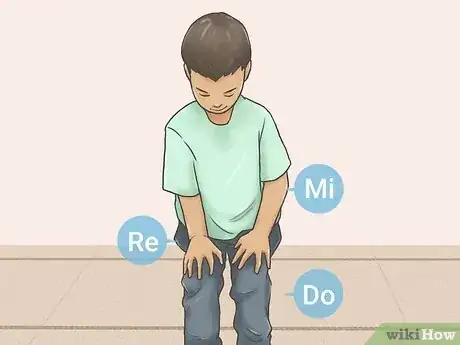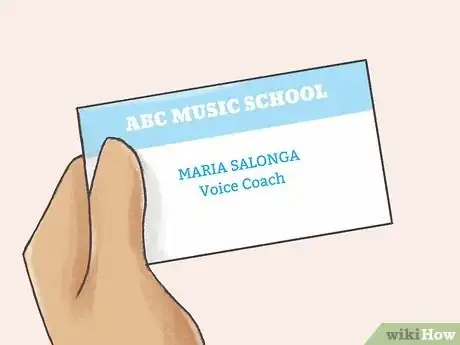This article was co-authored by Annabeth Novitzki. Annabeth Novitzki is a Private Music Teacher in Austin, Texas. She received her BFA in Vocal Performance from Carnegie Mellon University in 2004 and her Master of Music in Vocal Performance from the University of Memphis in 2012. She has been teaching music lessons since 2004.
There are 7 references cited in this article, which can be found at the bottom of the page.
wikiHow marks an article as reader-approved once it receives enough positive feedback. This article received 12 testimonials and 88% of readers who voted found it helpful, earning it our reader-approved status.
This article has been viewed 464,246 times.
Singing is an invaluable skill that many children love to learn. If you start teaching kids to sing young, this can foster a lifelong love of music. Start with basic notes and keys and then teach children a few songs and exercises. As singing is a technical skill, professional can help to really develop children's voices. However, even without the help of a trained coach, the children in your life can learn to love the art of singing.
Steps
Teaching the Basics
-
1Warm up with yawning. Before you start practicing singing, have the children take a deep breath and then yawn. This will open the throat to prevent strain when singing.[1]
-
2Practice breathing. Children need to learn how to breathe properly when singing. Do some breathing exercises so they can understand how to regulate breath while they sing.[2]
- Have the kids breathe in through their noses and out through their mouths.
- Encourage the kids to direct air into their stomachs and diaphragms instead of their chests. Have them place their hands on their stomachs and tell them to direct air so their stomachs rise.
- Have the kids count when they breathe. Have them inhale for 4 counts and then exhale for 4 counts.
Advertisement -
3Find a note that comes naturally. Have the child sing something like "la" or "ah" and figure out what their natural pitch is. Use a pitch gauge to measure their pitch. You can also play a few notes on a piano or other instrument to find a note near the child's range.[3]
-
4Use the note as a base to explore scales. Once each child has their starting point, you can use this as a basis to explore common beginning scales. Walk them through a basic A/B/C scale, using a recording of scales to help. Start near the child's natural range and have them move up and down the scale as needed.[4]
- Don't worry if the child does not hit notes perfectly right away. The point is to get a rough feel of their pitch. You can work on accuracy later.
-
5Illustrate scales and pitch with visuals. Children respond to visual cues. Raise your hand up and down to instruct a child to raise and lower their pitch. You can also try using body parts to teach the do-re-mi scale. For example, place your hands on your knees for "do," move your hands to your thighs for "re" and so on.[5]
Teaching with Games and Routines
-
1Illustrate tone and pitch through singing. If you have a good singing voice, sing to illustrate tone and pitch. If you're teaching children, you can sing songs you're teaching first. If you're a parent, make singing a daily part of your routine. Sing throughout the day and sing your child lullabies each night.[6]
- If you're not a singer yourself, you can always play the child songs by talented vocalists.
- If you're a teacher, encourage parents to sing to their kids at home.
-
2Start with simple songs. You can look up age-appropriate songs online and even purchase song books for various age groups at a local bookstore. Children can benefit from learning simple classics, like "The Itsy Bitsy Spider" and "Mary Had A Little Lamb." These songs have simple words and melodies that teach the basics.[7]
- If you're a parent, download recordings of such songs online. Play them in the background while the kids are playing or doing chores to bring music into their lives.
-
3Play pitch matching games. Sing a note like "la" and have the children repeat the note to you. Keep singing back and forth until they begin hitting the note. Sing a variety of notes across basic scales. This kind of imitation game helps children learn how to recognize tone and maneuver their voices to match it.[8]
- It can help to use a pitch gauge to make sure everyone is in tune.
- To keep children invested, offer small rewards during the game. You can hand out stickers when the kids match the pitch, for instance.
-
4Use call and echo songs. Call and echo songs are songs that involve children responding to prompts from a song's leader. The speaker may repeat the words back exactly or add an embellishment like "La-dee-da." These can be great songs to teach children to sing in tune. Many songbooks for young children contain these types of songs.[9]
- Examples include things like "Camp Town Races," "I Met a Bear," and "The Green Grass Grew All Around."
-
5Have the kids make up songs. Get a little silly and fun by telling your singing pupils to make up songs themselves. Kids can sing songs about magic worlds, tiresome chores, fantastic eating, and more. You can have them use familiar tunes from classic childhood favorites or make up their own tunes. This is another way to expose children to music regularly, letting them learn about singing naturally throughout their day to day lives.[10]
- If you're teaching a class, try asking the kids to make up their own songs in teams.
Enrolling Children in Classes and Extracurriculars
-
1Enroll the child in extracurriculars involving singing. Many schools offer extracurriculars for free, so take advantage of this. If the child's school has a choir, encourage the child to enroll. If a child can pick optional classes for a given semester, encourage them to take classes that involve singing.
- Extracurriculars don't always have to be directly related to singing. Things like band and even a music appreciate course can help develop the child's singing skills.
-
2Hire a voice teacher. If it's within your budget, search online for local voice teachers. It can be hard to teach children the technical aspects of singing if you're not professionally trained. A personal voice teacher can be invaluable when it comes to teaching children to sing.
- Look for a voice teacher with experience working with children. Children respond to different teaching methods than adults, so they'll benefit from a teacher who knows how to talk to kids.
-
3Look for online lessons. Online lessons are often cheaper than professional voice teachers. You can buy access to an online course that will provide with materials you can teach. Online courses sometimes also include occasional evaluations from a real instructor via things like Skype.
-
4Have the child join a choir. Look for children's choirs in your area and consider having the child sign up. If the child's church has a children's choir, for example, have them enroll. Singing with other children, under the direction of a professional, can really help the child hone their singing skills.
Expert Q&A
Did you know you can get expert answers for this article?
Unlock expert answers by supporting wikiHow
-
QuestionMy friends think I sound good and my parents say I'm not bad, but I have a deep voice and I'm a girl -- can I still be a good singer?
 Annabeth NovitzkiAnnabeth Novitzki is a Private Music Teacher in Austin, Texas. She received her BFA in Vocal Performance from Carnegie Mellon University in 2004 and her Master of Music in Vocal Performance from the University of Memphis in 2012. She has been teaching music lessons since 2004.
Annabeth NovitzkiAnnabeth Novitzki is a Private Music Teacher in Austin, Texas. She received her BFA in Vocal Performance from Carnegie Mellon University in 2004 and her Master of Music in Vocal Performance from the University of Memphis in 2012. She has been teaching music lessons since 2004.
Music Teacher
-
QuestionWhat can happen if you started singing without any problems or training, and it sounds good?
 Community AnswerThat means you have talent. You should take your voice further by getting lessons to expand your range.
Community AnswerThat means you have talent. You should take your voice further by getting lessons to expand your range. -
QuestionIs it dangerous if you are a child and you sing a lot without having vocal lessons?
 LucyCommunity AnswerIf you are screaming or going out of your physical vocal range, it can be dangerous. Otherwise, it is not at all dangerous. If it is painful to sing, you know you are out of your vocal range.
LucyCommunity AnswerIf you are screaming or going out of your physical vocal range, it can be dangerous. Otherwise, it is not at all dangerous. If it is painful to sing, you know you are out of your vocal range.
References
- ↑ http://www.bbc.co.uk/sing/learning/warmingup.shtml
- ↑ http://www.bbc.co.uk/sing/learning/warmingup.shtml
- ↑ https://www.musical-u.com/learn/how-to-teach-someone-to-sing-in-tune/
- ↑ https://www.youtube.com/watch?v=lH6cZFk5iPg
- ↑ https://thebubblebox.com.au/blog/do-re-mi-solfege-hand-signs-teach-young-children/
- ↑ https://simplymusic.com/lullabies-parent-children/
- ↑ https://www.thoughtco.com/teach-kids-to-sing-2994281
- ↑ https://www.thoughtco.com/teach-kids-to-sing-2994281
- ↑ https://www.thoughtco.com/teach-kids-to-sing-2994281
About This Article
To teach a child to sing, practice scales and simple songs with them so they start to get an ear for pitch and tone. Start off by having your child sing along to a scale like “Do Re Mi” with you or a recording. Sing to them or play them recordings of good singers so they start to get used to pitches. Try raising your hand up and down to show them when the pitch rises and falls. You can also try playing pitch matching games with your child, where you sing a note or phrase and they have to copy. Once they have a basic understanding of pitch, have them join in with nursery rhymes, like “Itsy Bitsy Spider” and “Mary Had a Little Lamb.” For more tips from our Music co-author, including how to find a singing group for your child, read on!




















-Step-15.webp)






















































